Part One: Melody
Focuses on single note soloing. Learn how to effortlessly solo through complex chord changes.
Free Jazz Guitar Lessons with Chris Standring
If you think of all new chords from here on out as
stemming from their parent chord then you will understand the fretboard
well. For instance, a minor 7th chord is simply a minor chord with an
added embellishment, the 7th degree of that chord. A dominant 7th chord
is simply a major chord with an added embellishment, again the 7th degree
of that chord.
So let's have a look at a new chord. This is called the major 7th
chord. Now, remember that there are two types of 7th chords. One
is the dominant 7th chord and is an embellishment of a major chord,
but it is a 'dominant' chord which means it is always used as chord
5 in our stock key chord sequence. A major 7th chord is also
an embellishment of a major chord but it is not ever used as a dominant
chord. It is usually used as an embellishment of chord one (i) or four
(iv). So in the key of G major, our home key chord is G major. In many
situations, G maj7th is an appealing substitute chord, or embellishment
for this home key chord.
Embellishments literally add flavor to music and produce feelings that
often put us in a specific musical genre. For instance, a major 7th
chord is pretty and quite a Jazzy sound. It is also used extensively
in R&B and Soul music. It is found in Pop songs and torchsong style
ballads but it is literally never heard in Hard Rock music as the sound
is just too pretty. So let's have a quick look at this new chord and
effective ways we can play it on the guitar.
Here it is as a movable chord with a 6th string root:
C major7 (6th string root version)

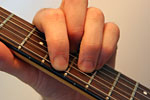
You will see that I have not fingered this chord as a barre chord, although it could be, but two notes should be muted and this is the best way to do that. The top string can be muted with the base of the first finger and the 5th string can be muted using the top part of the first finger. Associate this chord with its parent major chord form with a 6th string root:
C major (6th string root parent chord)

You will notice that the 4th finger moves back one
fret, the 3rd finger is removed (this is optional - we already have
this G note in the chord so it is simply doubled and therefore not necessary)
and in order to play this effectively we need to re-finger the chord,
as we don't need the barre now.
Now move this chord up and down chromatically so you get a feel for
how the chord sounds at different fret locations. Try to memorize the
names of the chords at different locations.
Coolness. So let's now have a look at a 5th string root version of this major 7th chord:
C major7 (5th string root version)

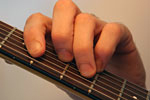
This shape will need to be played using a first finger barre. Mute the bottom E string or simply strum/articulate the strings from the 5th string upwards. Again, associate this chord with its parent major chord form with a 5th string root:
C major (5th string root parent chord)

Now move this chord up and down chromatically so you get a feel for how the chord sounds at different fret locations. Try to memorize the names of the chords at different locations.
Finally, take a look at a few major 7th chords in open position. These will be good to remember but not strictly movable so look at them as isolated chords that might appeal to you. You can certainly use them if you like the way they sound.

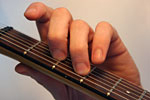

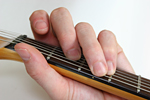
This version of Cmaj7 has a G in the bass so technically it would be called Cmaj7/G but it functions well as a C major7 chord

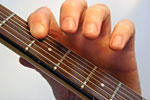

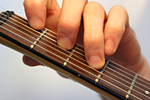

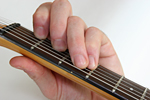
This version of Fmaj7 has a C in the bass so technically
it would be called Fmaj7/C but it functions well as an Fmajor7 chord

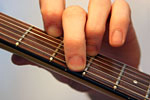

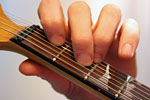
Notice that there are two ways to play C major7 and F major7. The first is the correct way, the second is also fine except that because the root note of the chord is not in the bass, the chord should not strictly be named as such. However, a bass player would play the root note to define the chord so in this instance it is perfectly fine, after all the voicings sound very pleasing.
Free online jazz guitar lessons for beginners, intermediates and advanced.
Online jazz guitar instruction from recording artist Chris Standring
Join The Inside Track membership and get access to all Chris Standring's guitar instructional programs, all in one place.
It has been many years since the first edition of Play What You Hear (originally released in 2000). Now volume two is here with new ideas and concepts, complete with audio, video, traditional notation and TAB throughout. High resolution pdf available for printing the entire program. For intermediate and advanced players.
Focuses on single note soloing. Learn how to effortlessly solo through complex chord changes.
Focuses on chord melody. Learn new harmonic devices and understand chords in a whole new way.
Study Chris Standring's six recorded solos, transcribed with audio and high def video.
Copyright © PlayJazzGuitar.com - All Rights Reserved.